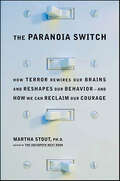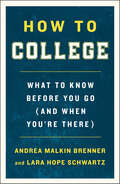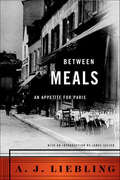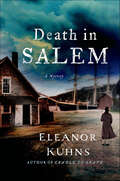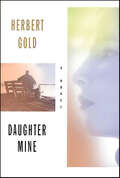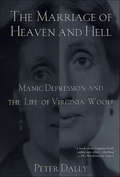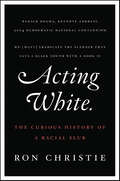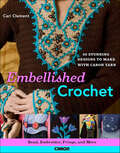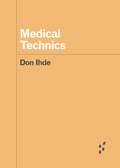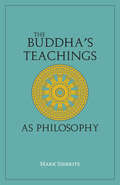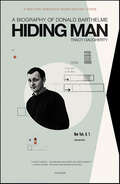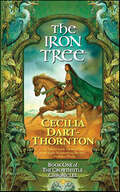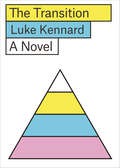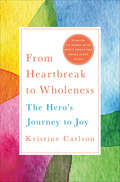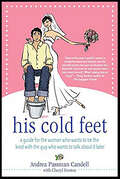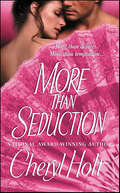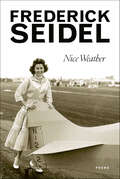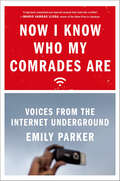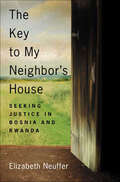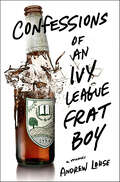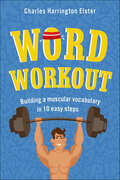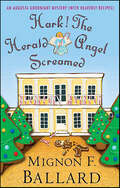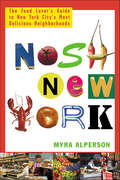- Table View
- List View
The Paranoia Switch: How Terror Rewires Our Brains and Reshapes Our Behavior—and How We Can Reclaim Our Courage
by Martha StoutOn September 11, 2001, the "Fear Switch" in our brains got flicked. How do we turn it off and reclaim our lives?Five years after September 11, we're still scared. And why not? Terrorists could strike at any moment. Our country is at war. The polar caps are melting. Hurricanes loom. We struggle to control our fear so that we can go about our daily lives. Our national consciousness has been torqued by trauma, in the process transforming our behavior, our expectations, our legal system. In The Myth of Sanity, Martha Stout, who until recently taught at the Harvard Medical School, analyzed how we cope with personal trauma. In her national bestseller The Sociopath Next Door, she showed how to avoid suffering psychological damage at the hands of others. Now, in The Paranoia Switch, she offers a groundbreaking clinical, neuropsychological, and practical examination of what terror and fear politics have done to our minds, and to the very biology of our brains. In this timely and essential book, Stout assures us that we can interrupt the cycle of trauma and look forward to a future free of fear only by understanding our own paranoia—and what flips the paranoia switch.
How to College: What to Know Before You Go (and When You're There)
by Andrea Malkin Brenner Lara Hope SchwartzThe first practical guide of its kind that helps students transition smoothly from high school to collegeThe transition from high school—and home—to college can be stressful. Students and parents often arrive on campus unprepared for what college is really like. Academic standards and expectations are different from high school; families aren’t present to serve as “scaffolding” for students; and first-years have to do what they call “adulting.” Nothing in the college admissions process prepares students for these new realities.As a result, first-year college students report higher stress, more mental health issues, and lower completion rates than in the past. In fact, up to one third of first-year college students will not return for their second year—and colleges are reporting an increase in underprepared first-year students.How to College is here to help. Professors Andrea Malkin Brenner and Lara Schwartz guide first-year students and their families through the transition process, during the summer after high school graduation and throughout the school year, preparing students to succeed and thrive as they transition and adapt to college. The book draws on the authors’ experience teaching, writing curricula, and designing programs for thousands of first-year college students over decades.
Between Meals: An Appetite for Paris (Modern Library Ser.)
by A. J. LieblingNew Yorker staff writer A.J. Liebling recalls his Parisian apprenticeship in the fine art of eating in this charming memoir, Between Meals: An Appetite for Paris.“There would come a time when, if I had compared my life to a cake, the sojourns in Paris would have presented the chocolate filling. The intervening layers were plain sponge.”In his nostalgic review of his Rabelaisian initiation into life’s finer pleasures, Liebling celebrates the richness and variety of French food, fondly recalling great meals and memorable wines. He writes with awe and a touch of envy of his friend and mentor Yves Mirande, “one of the last great gastronomes of France,” who would dispatch a lunch of “raw Bayonne ham and fresh figs, a hot sausage in crust, spindles of filleted pike in a rich rose sauce Nantua, a leg of lamb larded with anchovies, artichokes on a pedestal of foie gras, and four or five kinds of cheese, with a good bottle of Bordeaux and one of Champagne”—all before beginning to contemplate dinner.In A.J. Liebling, a great writer and a great eater became one, for he offers readers a rare and bountiful feast in this delectable book. With an introduction by James Salter, PEN/Faulkner Award-winning author of A Sport and a Pastime
Death in Salem: A Mystery (Will Rees Mysteries)
by Eleanor KuhnsIt's 1796, and traveling weaver Will Rees is visiting Salem, Massachusetts. He's in town to buy a luxurious gift for his pregnant wife, a few yards of well-made fabric from the traders at the famed Salem harbor. While traveling through Salem, however, Rees comes upon a funeral procession for the deceased Mrs. Antiss Boothe. When Rees happens upon Twig, a friend who fought alongside him in the war, he learns that Mrs. Boothe had been very ill, and her death had not come as a surprise. But the next morning, the town is abuzz with the news that Mr. Boothe has also died—and this time it is clearly murder. When the woman that Twig loves falls under suspicion, Twig persuades Rees to stay in Salem, despite the family waiting for him back home in Maine, and help solve the murder.Rees is quickly pulled into the murky politics of both Salem and the Boothe family, who have long been involved in the robust shipping and trading industry on the Salem harbor. Everyone Rees meets seems to be keeping some kind of secret, but could any of them actually have committed murder?Will Rees returns in Death in Salem, the next delightful historical mystery from MB/MWA First Novel Competition winner Eleanor Kuhns.
A Rage for Order: The Middle East in Turmoil, from Tahrir Square to ISIS
by Robert F. WorthThe definitive work of literary journalism on the Arab Spring and its troubled aftermathIn 2011, a wave of revolution spread through the Middle East as protesters demanded an end to tyranny, corruption, and economic decay. From Egypt to Yemen, a generation of young Arabs insisted on a new ethos of common citizenship. Five years later, their utopian aspirations have taken on a darker cast as old divides reemerge and deepen. In one country after another, brutal terrorists and dictators have risen to the top. A Rage for Order is the first work of literary journalism to track the tormented legacy of what was once called the Arab Spring. In the style of V. S. Naipaul and Lawrence Wright, the distinguished New York Times correspondent Robert F. Worth brings the history of the present to life through vivid stories and portraits. We meet a Libyan rebel who must decide whether to kill the Qaddafi-regime torturer who murdered his brother; a Yemeni farmer who lives in servitude to a poetry-writing, dungeon-operating chieftain; and an Egyptian doctor who is caught between his loyalty to the Muslim Brotherhood and his hopes for a new, tolerant democracy. Combining dramatic storytelling with an original analysis of the Arab world today, A Rage for Order captures the psychic and actual civil wars raging throughout the Middle East, and explains how the dream of an Arab renaissance gave way to a new age of discord.
Daughter Mine: A Novel
by Herbert GoldDan Shaper, bachelor, translator for the San Francisco courts, is a man who has worn the same raincoat for fifteen years, eats the same breakfast in the same coffeeshop every morning, occasionally sees a few long-time men friends and vaguely regrets a handful of former women lovers. In the sixties and seventies, Shaper was where the action was, (San Francisco, where else?) and joined in the festivities, if moderately. But that was a long time ago. There are those who have drug flashbacks, even years after they've been using. Shaper has escaped those, thanks to his moderation. But into his relatively Spartan life now comes a flashback of another kind - a nineteen-year-old daughter whose existence he never suspected. Her mother was an overnight acquaintance whom with some effort he manages, barely, to recall. The daughter's name is Amanda, and her phone call sends Shaper's drab-gray existence into dazzling Technicolor. Amanda arrives trailing a motley band of associates: a con man who explains his activities on his gypsy heritage, except that he may not have one; his blatantly seductive daughter; Amanda's boyfriend, D'Wayne, a streetsmart and (usually) genial black giant. The con man owns what he has named The Yerba Buena Foundation, dedicated to helping businessmen relieve stress; his daughter - well, she runs the place, D'Wayne is the house's security man. Others turn up, segueing from various areas of Shaper's life. Amanda, part typical teenager, part young receptacle of ancient wisdom, is currently employed as a "therapist" at the Foundation. Shaper plunges into this personal mosh pit like a repentant sinner at a river baptism, the shock of his plunge awakening him to the realization that there's more in life than was dreamt of in his philosophy. Gold has been blessing readers with his contemplation of the human condition for many years. In this novel his lovely humor and deep understanding illuminates how a man walking a barren highway may react when fate suddenly shoves him onto an unpaved, rutted dirt road.
The Marriage of Heaven and Hell: Manic Depression and the Life of Virginia Woolf
by Peter DallyCombining his knowledge as a doctor and a lifelong fascination with Virginia Woolf's life and work, eminent psychiatrist Peter Dally offers a haunting and compelling look at the depression that tormented Virginia Woolf throughout her adult years, in The Marriage of Heaven and Hell: Manic Depression and the Life of Virginia Woolf.On three occasions Virginia went mad. Symptoms of these episodes included conversations with her dead mother, and hearing birds speak in Greek. Though a quiet life cushioned her childhood, the renown that Woolf achieved through writing inspired the bouts of depression and elation that she regularly experienced as an adult. This terrified Virginia, and though the experience offered extraordinary insight into her craft, Woolf lived in constant fear of her dreadful affliction.Virginia's most vital protection from stress was her husband, Leonard. Without his constant vigilance and care, it is doubtful she would have been so creatively productive. Yet, paradoxically, their marriage ultimately precipitated her most dangerous bout of madness. Toward the end of her life, when events outside the couple's control led to Leonard's own depression and gradual withdrawal, Virginia found herself facing madness alone, and with tragic results.Compassionate and disturbing, this fascinating study is the first to look at Virginia Woolf's life from the perspective of her illness.
Acting White: The Curious History of a Racial Slur
by Ron ChristieIn the tradition of Randall Kennedy's Nigger and Shelby Steele's The Content of Our Character, Acting White demonstrates how the charge that any African-American who is successful, well mannered, or well educated is "acting white," is a slur that continues to haunt blacks. Ron Christie traces the complex history of the phrase, from Uncle Tom's Cabin to the tensions between Martin Luther King, Jr., and Malcolm X to Bill Cosby's controversial NAACP speech in 2004. The author also writes candidly of being challenged by black students for his "acting white," and also of being labeled a race traitor in Congress by daring to be Republican. This lucid chronicle reveals how this prevalent put-down sets back much of the hard-earned progress for all blacks in American society. Deftly argued and determinedly controversial, this book is certain to spur thoughtful discussion for years to come.
Embellished Crochet: Bead, Embroider, Fringe, and More (Knit & Crochet)
by Cari ClementTwo of the hottest fashion trends in recent years---both embellishing and crocheting have emerged as sophisticated fashion influences. Embellished Crochet provides clear, illustrated instructions for all the fabulous embellishments included, with concise explanations and detailed step-by-step photos so you can either re-create them on the projects featured or use them as inspiration for your own designs. Each type of embellishment, from beading to embroidery to embellishing with braid, is shown in full-color close-up photography, with charts and stitch diagrams demonstrating how to work each step along the way.There are complete directions for making every crocheted project in the book. Organized by theme into six sections---Focus on Color, The Domino Effect, Out of Africa, Got the Blues, Orient Express, and Evening Elegance---each has a variety of projects from the simple to the more complex, ranging from bangles to bags to boleros.Jam-packed with innovative ideas and techniques for embellishing, this is a book that will appeal to all crocheters in search of new ideas and inspiration. And all are made in easy to work with and widely available Caron yarn.A wide variety of decoration, patterns, and embellishments adorn the beautifully crafted crocheted garments and accessories in this book conceived by Cari Clement, Caron Yarn's Director of Fashion and Design. You'll be thrilled with these delightful and appealing designs, from a variety of different knitwear designers---and all of the amazing designs are worked in widely available Caron International Yarns.Features:-clear, illustrated instructions for all the embellishments-concise explanations and detailed step-by-step photos-complete project directions for making every fabulous sweater, wrap, bag, and more
Medical Technics (Forerunners: Ideas First)
by Don IhdeA personal account of the aging body and advanced technologies by a preeminent philosopher of technologyMedical Technics is a rigorous examination of how medical progress has modified our worlds and contributed to a virtual revolution in longevity. Don Ihde offers a unique autobiographical tour of medical events experienced in a decade, beginning in his 70s. Ihde offers experiential and postphenomenological analyses of technologies such as sonography and microsurgery, and ultimately asks what it means to increasingly become a cyborg. Forerunners: Ideas FirstShort books of thought-in-process scholarship, where intense analysis, questioning, and speculation take the lead
Spoiler Alert: A Critical Guide (Forerunners: Ideas First)
by Aaron JaffeAll of this information at our fingertips—and we might not need any of itConcurrent with the compulsory connectivity of the digital age is the rise of the spoiler. The inevitability of information has changed the critical quality of modernity, leaving us with acute vertigo—a feeling that nothing new is left out there. Encompassing memes and trigger warnings, Vilem Flusser and Thomas Pynchon, Spoiler Alert wrangles with the state of surprise in post-historical times. Aaron Jaffe delivers a timely corrective to post-critical modes of reading that demonstrates the dangers of forfeiting critical suspicion.Forerunners: Ideas FirstShort books of thought-in-process scholarship, where intense analysis, questioning, and speculation take the lead
The Buddha's Teachings As Philosophy
by Mark SideritsA shorter and less technical treatment of its subject than the author&’s acclaimed Buddhism As Philosophy (second edition, Hackett, 2021), Mark Siderits's The Buddha&’s Teachings As Philosophy explores three different systems of thought that arose from core claims of the Buddha. By detailing and critically examining key arguments made by the Buddha and developed by later Buddhist philosophers, Siderits investigates the Buddha's teachings as philosophy: a set of claims—in this case, claims about the nature of the world and our place in it—supported by rational argumentation and, here, developed with a variety of systematic results. The Buddha&’s Teachings As Philosophy will be especially useful to students of philosophy, religious studies, and comparative religion—to anyone, in fact, encountering Buddhist philosophy for the first time.
Hiding Man: A Biography of Donald Barthelme
by Tracy DaughertyIn the 1960s Donald Barthelme came to prominence as the leader of the Postmodern movement. He was a fixture at the New Yorker, publishing more than 100 short stories, including such masterpieces as "Me and Miss Mandible," the tale of a thirty-five-year-old sent to elementary school by clerical error, and "A Shower of Gold," in which a sculptor agrees to appear on the existentialist game show Who Am I? He had a dynamic relationship with his father that influenced much of his fiction. He worked as an editor, a designer, a curator, a news reporter, and a teacher. He was at the forefront of literary Greenwich Village which saw him develop lasting friendships with Thomas Pynchon, Kurt Vonnegut, Tom Wolfe, Grace Paley, and Norman Mailer. Married four times, he had a volatile private life. He died of cancer in 1989. The recipient of many prestigious literary awards, he is best remembered for the classic novels Snow White, The Dead Father, and many short stories, all of which remain in print today. Hiding Man is the first biography of Donald Barthelme, and it is nothing short of a masterpiece.
The Iron Tree (The Crowthistle Chronicles)
by Cecilia Dart-ThorntonJarred is a young boy who has grown up among his mother's peaceful desert people. While Jarred loves his mother, he longs to know the history of his father, a journeyman who left years earlier, promising to return for his wife and infant son. A broken promise but a token left behind--an amulet for Jarred that he has worn always. Some say it brings more than a bit of good luck his way, for no harm has ever befallen the boy.When Jarred comes to manhood, he decides to journey into the world to seek his fortune and perhaps along the way find news of his father. In his travels he will come to a place so unlike his own as to boggle his mind--a place of immense tracts of waterways and marshes, where the very air seems to teem with magic and a people surrounded by creatures fey and not, with enough strange customs and superstitions to make his head swirl.And to the beautiful Lilith, a woman who will haunt his dreams and ultimately steal his heart...who perhaps can provide a key to his heritage.At the Publisher's request, this title is being sold without Digital Rights Management Software (DRM) applied.
The Transition: A Novel
by Luke Kennard“The sort of book that cuts you off from your family and has you walking blindly through seven lanes of traffic with your face pressed obliviously to the page.” —James Marriott, The Times (London)Do you or your partner spend more than you earn? Have your credit card debts evolved into collection letters? Has either of you received a court summons? Has either of you considered turning to a life of a crime? You are not alone. We know. We can help.Welcome to the Transition.While taking part in the Transition, you and your partner will spend six months living under the supervision of your mentors, two successful adults of a slightly older generation. Freed from your financial responsibilities, you will be coached through the key areas of the scheme—Employment, Nutrition, Responsibility, Relationship, Finances, and Self-respect—until you are ready to be reintegrated into adult society. At the end of your six months, who knows what discoveries you’ll have made about yourself? The “friends” you no longer need. The talents you’ll have found time to nurture. The business you might have kick-started. Who knows where you’ll be?
From Heartbreak to Wholeness: The Hero's Journey to Joy
by Kristine CarlsonA guidebook for discovering how heartbreak can become the doorway to profound meaning and joy from the bestselling co-creator of the Don’t Sweat the Small Stuff SeriesIn 2006, after building the bestselling franchise Don’t Sweat the Small Stuff with her husband Richard, Kristine Carlson faced a shattering loss—the sudden death of her beloved spouse. Woven together with the remarkable stories of others’ loss and recovery, her deeply moving story reveals a clear process of healing that is common to everyone and goes far beyond ordinary prescriptions for getting through hard times. In her new book, From Heartbreak to Wholeness, Kristine offers a life-altering map for navigating the heroic journey from loss to joy—one that ultimately awakens readers to a deep love affair with life.Every day, people suffer heartbreaks of some kind—loss of a loved one, divorce, illness, loss of a job or home—and seek to understand why these losses and traumas have befallen them and how they’ll make it through in one piece. For readers who have endured loss of any kind, Kristine takes them by the hand, showing them how to traverse their own jagged edge of growth and emerge as the hero whole, happy, and empowered. Each chapter of From Heartbreak to Wholeness includes powerful exercises in self-inquiry and reflection, along with step-by-step guidance for writing one’s own heroic story of healing. Journey with Kristine Carlson and learn how you can walk the path from heartbreak to wholeness.
His Cold Feet: A Guide for the Woman Who Wants to Tie the Knot with the Guy Who Wants to Talk About It Later
by Andrea Passman Candell Cheryl FentonFinally, a book that offers a behind-the-scenes look at what happens when she is ready to tie the knot and he prefers to talk about it later. His Cold Feet is a collection of stories, commentaries, and practical advice that will ultimately create a bridge between women and men, enabling each to better understand the other's experience when facing a marriage commitment. His Cold Feet is the ultimate guide and a definite must-read for the woman who feels stuck in neutral within her relationship. In His Cold Feet, you'll find:• Advice on how to have "the talk"• How to deal with the dreaded "When are you two getting married?"• The scoop on ultimatums• A man's perspective on popping the question• How to manage "pre-engagement limbo"• How to find out what's really behind his cold feet• When to walk away And lots of other crucial, sanity-saving advice.
More Than Seduction
by Cheryl HoltMrs. Anne Smythe's Healing Spa and Bathing Emporium is a haven for fashionable women who believe the waters have aphrodisiac properties. Yet the prim proprietress never thinks of testing that theory-until grievously injured Captain Stephen Chamberlin is deposited on her doorstep. Every minute the war hero spends under her roof courts scandal. It isn't long before she discovers that having such a man at her mercy arouses her in ways she never thought possible as their "therapeutic" sessions in the hot springs have become steamy trysts Anne wishes would never end...Stephen thought he had reached his lowest point when the war rendered him an invalid. He's proven wrong when his sister and best friend leave him in the care of the tantalizing Mrs. Anne Smythe. Yet as the healing waters work their magic, so does the widow Smythe. Beneath her unflappable exterior lies an alluring woman: warm, witty, and refreshingly open to sensual experimentation. But when mutual pleasure turns to forbidden love, can two people outwit the forces that would see them torn apart?
Nice Weather: Poems
by Frederick SeidelA stunning new collection from the "beguiling and magisterial" poet (The New York Times Book Review)"Something is going on. Something is wrong."Frederick Seidel-the "ghoul" (Chicago Review), the "triumphant outsider" (Contemporary Poetry Review)-returns with a dangerous new collection of poems. Nice Weather presents the sexual and political themes that have long preoccupied Seidel-and thrilled and offended his readers. Lyrical, grotesque, elegiac, this book adds new music and menace to his masterful body of work.
Now I Know Who My Comrades Are: Voices from the Internet Underground
by Emily ParkerIn China, university students use the Internet to save the life of an attempted murder victim. In Cuba, authorities unsuccessfully try to silence an online critic by sowing seeds of distrust in her marriage. And in Russia, a lone blogger rises to become one of the most prominent opposition figures since the fall of the Soviet Union. Authoritarian governments try to isolate individuals from one another, but in the age of social media freedom of speech is impossible to contain. Online, people discover that they are not alone. As one blogger put it, "Now I know who my comrades are."In her groundbreaking book, Now I Know Who My Comrades Are: Voices from the Internet Underground, Emily Parker, formerly a State Department policy advisor, writer at The Wall Street Journal and editor at The New York Times, provides on-the-ground accounts of how the Internet is transforming lives in China, Cuba, and Russia.It's a new phenomenon, but one that's already brought about significant political change. In 2011 ordinary Egyptians, many armed with little more than mobile phones, helped topple a thirty-year-old dictatorship. It was an extraordinary moment in modern history—and Now I Know Who My Comrades Are takes us beyond the Middle East to the next major civil rights battles between the Internet and state control.Star dissidents such as Cuba's Yoani Sánchez and China's Ai Weiwei are profiled. Here you'll also find lesser-known bloggers, as well as the back-stories of Internet activism celebrities. Parker charts the rise of Russia's Alexey Navalny from ordinary blogger to one of the greatest threats to Vladimir Putin's regime. This book introduces us to an army of bloggers and tweeters—generals and foot soldiers alike. These activists write in code to outsmart censors and launch online campaigns to get their friends out of jail. They refuse to be intimidated by surveillance cameras or citizen informers. Even as they navigate the risks of authoritarian life, they feel free. Now I Know Who My Comrades Are is their story.
The Key to My Neighbor's House: Seeking Justice in Bosnia and Rwanda
by Elizabeth NeufferInterviewing war criminals and their victims, Neuffer explains, through the voices of people she follows over the course of a decade, how genocide erodes a nation's social and political environment. Her characters' stories and their competing notions of justice-from searching for the bodies of loved ones, to demanding war crime trials, to seeking bloody revenge-convinces readers that crimes against humanity cannot be resolved by simple talk of forgiveness,or through the more common recourse to forgetfulness.
Confessions of an Ivy League Frat Boy: A Memoir
by Andrew LohseAn account of sordidness and redemption by the Dartmouth fraternity member whose Rolling Stone profile blew the whistle on the frat's inhumane hazing practices.Always trust the brotherhood.Always protect your pledge brothers.What happens in the house stays in the house.Before attending Dartmouth, the worst thing Andrew Lohse had ever done was skip school to attend a John McCain rally. Growing up in suburban New Jersey, he was the typical American honor student: straight-As, on the lacrosse team, president of the Model U.N. He dreamed of following in his grandfather's footsteps and graduating from the Ivy League. When he arrived at Dartmouth, however, he found not the prestigious college of years past, but a wasteland of privilege and moral entropy. And when he rushed Sigma Alpha Epsilon, the fraternity that inspired the rival house in Animal House, Lohse's once-perfect life, as well as his goals, began to crumble around him.Lured by free booze and friendly brothers, Andrew pledged Sigma Alpha Epsilon, and soon his life became a dangerous cycle of binge drinking and public humiliation. From chugging vinegar to swimming in a pool of human waste, Lohse's pledge class endured cruelty and psychological coercion in the hopes of obtaining a bid. Although Andrew succeeded in joining the fraternity, the pattern of abuse continued—except over time, he became the abuser.Told by a contemporary Holden Caulfield, this is a shocking exposé of America's most exclusive institutions and a cautionary tale for modern times.
Word Workout: Building a Muscular Vocabulary in 10 Easy Steps
by Charles Harrington ElsterWord Workout is a practical book for building vocabulary—a graduated program featuring thousands of words that begins with those known by most college graduates and ascends to words known only by the most educated, intelligent, and well-read adults. This workout is a comprehensive program, chock-full of information about synonyms, antonyms, and word origins, and replete with advice on proper usage and pronunciation. There are also creative review quizzes at each step of the way to measure your progress and reinforce learning. Unlike other vocabulary books, Word Workout provides a complete learning experience with clear explanations and surefire methods to retain new knowledge. Far more than a cram session for a standardized test, this book is designed as a lifetime vocabulary builder, featuring words used by the top tier of literate Americans, laid out in ten accessible chapters designed for anyone who is looking for some serious verbal exercise.From "avowal" to "proselytize," from "demagogue" to "mendicant," Charles Harrington Elster has carefully picked the words you need to know, and given you an easy, fast, and fail-safe way to learn and remember them.
Hark! The Herald Angel Screamed (Augusta Goodnight Mysteries)
by Mignon F. BallardIt's Christmastime in the seemingly tranquil town of Stone's Throw, South Carolina, but amid all the caroling, cookies, and cheer, a murderer casts a not-so-jolly pall on the holiday season. Augusta Goodnight, guardian angel, sometime sleuth, and welcome boarder with longtime resident Lucy Nan Pilgrim, comes to the aid of her friends when, as Lucy Nan is searching for the perfect Christmas tree on her grandmother's abandoned estate, a mysterious stranger plummets to his death from the mansion's balcony. Lucy Nan can't shake off childhood stories of the ghost of a girl who fell from the same spot long ago---has the ghost come back to haunt the living, or is there an all-too-human murderer at work?Mysterious events are soon heating up faster than spiced punch left on the burner, and it will take Augusta's help, not to mention some celestial Southern cooking, for peace to be restored and Christmas lights to shine once again in the little town of Stone's Throw.
Nosh New York: The Food Lover's Guide to New York City's Most Delicious Neighborhoods
by Myra AlpersonWhether you're a lifelong New Yorker or you're visiting for the first time, when you're in the Big Apple you're in food heaven - a nosher's paradise where you can find the freshest and most authentic foods of any cuisine in the world, from steaming soup dumplings to Persian Kebabs, Moroccan tagines, Chinese bubble tea, Senegalese ginger beer, Colombian cholados, kosher focaccia bread, the freshest Italian cheeses, Guyanese roti and more! In this thorough and user-friendly book, passionate New York food guide Myra Alperson takes readers on her popular tours around town. Organized by borough and divided into easy-to-follow walks -- each of which can be done in an afternoon -- she points readers to the best ethnic restaurants, cafes, bakeries, tea houses, take-out stores, specialty shops, produce stands, supermarkets, and other food hot spots. From generations-old favorites to vibrant newcomers, the delicious discoveries and include the best:- Indian, Greek, Brazilian, Cuban, Romanian, Irish, Chinese, Afghan and Thai spots in Queens - Italian, Kosher, Caribbean, Polish, Scandinavian, Russian and Moroccan delights in Brooklyn- Chinese, West African, Soul Food, Mexican, Dominican, Korean and Turkish finds in Manhattan- Sicilian, Albanian, Jamaican and Cambodian delights in the Bronx- And much more.You'll also discover: New York's last authentic beer garden * where to buy Chilean hot dogs and Brazilian pizza* the newest wave of Egyptian markets * the last Kosher market in Brighton Beach and the only Norwegian market in New York City * fun and delectable side trips * vegetarian and kid-friendly finds * cultural information for each neighborhood, along with info on the best parks, museums, gift shops, and bookstores.Complete with subway, bus, and car directions along with detailed maps of each neighborhood covered, Nosh New York turns an afternoon in the city into a delicious food adventure.
